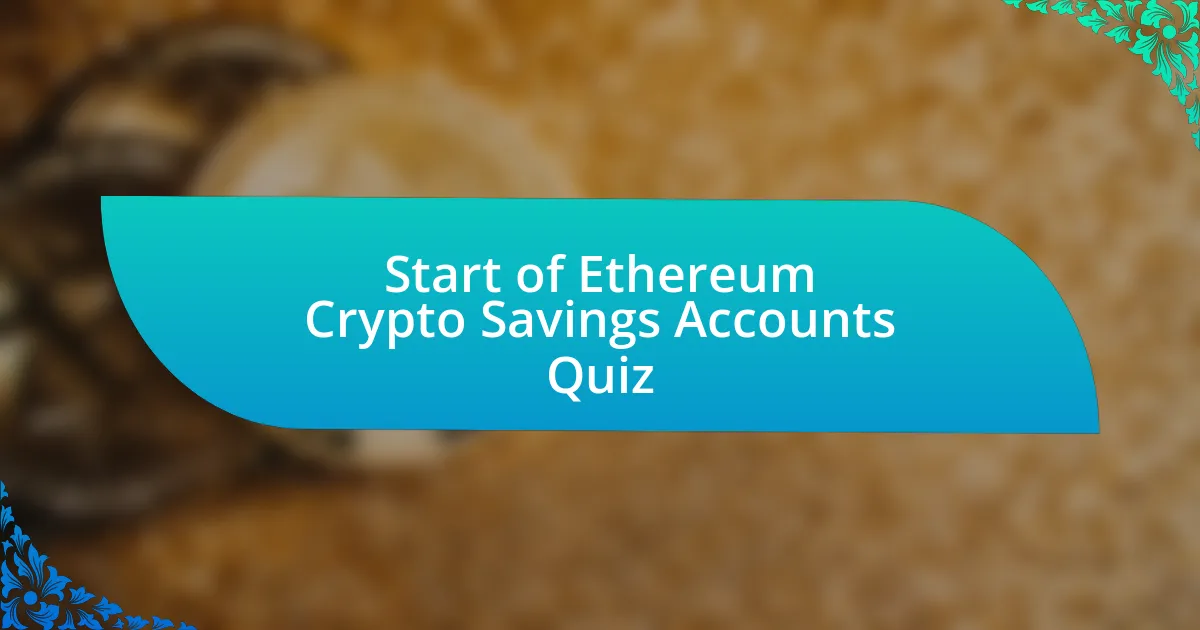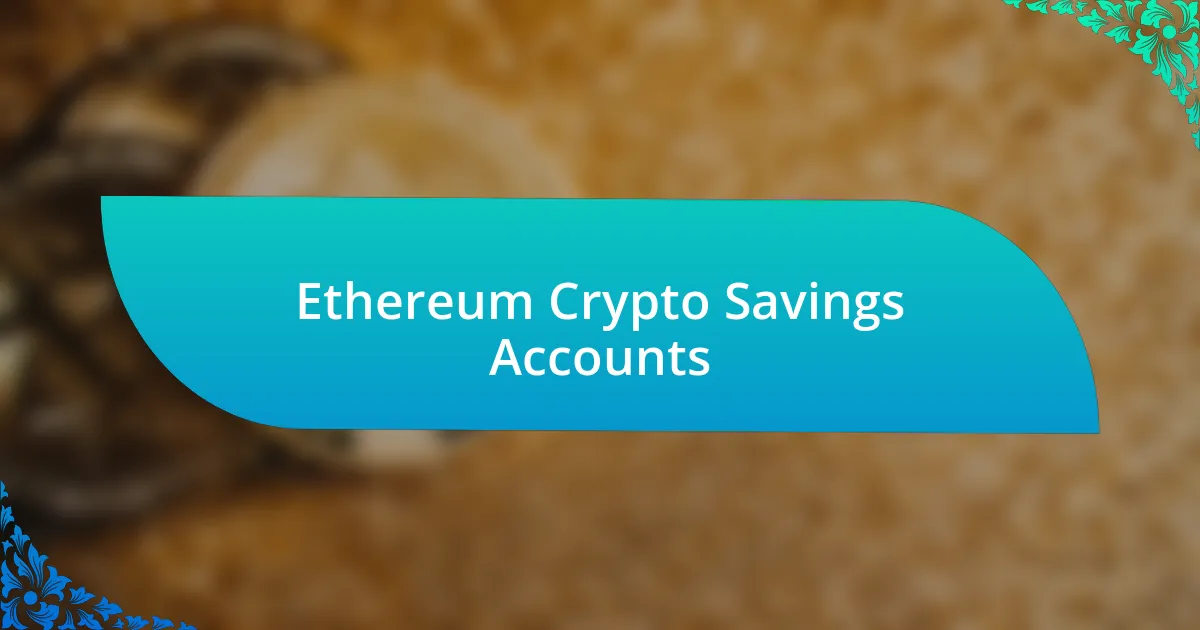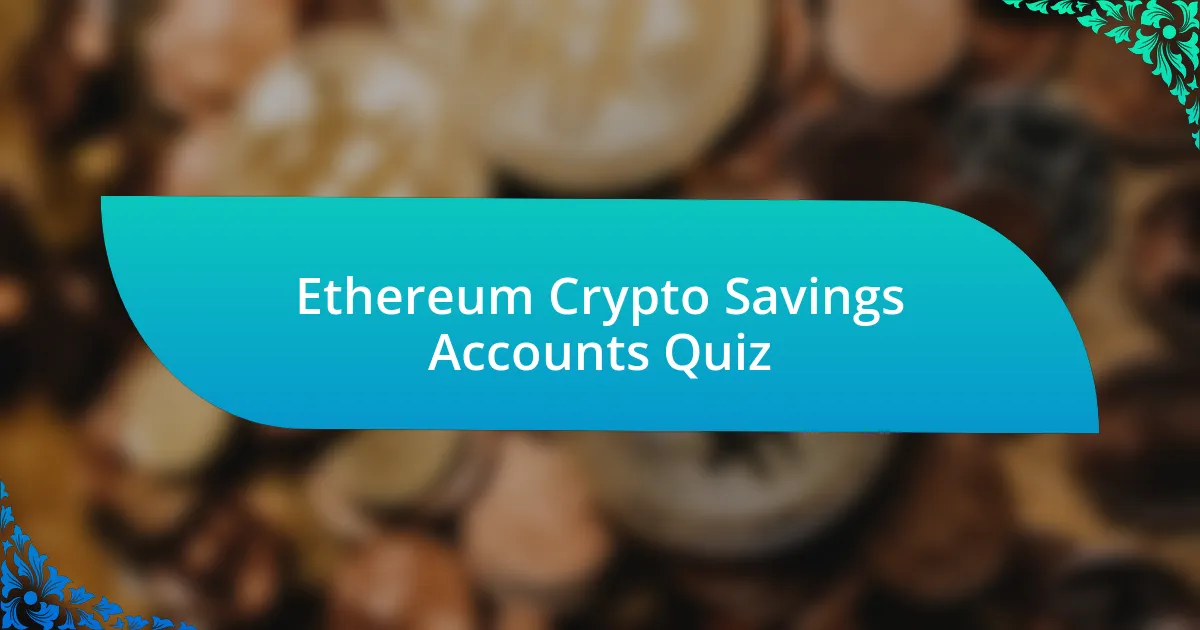
Start of Ethereum Crypto Savings Accounts Quiz
1. What is an Ethereum savings account?
- A marketplace for trading Ethereum without earning any interest.
- An account where users deposit their Ethereum and earn interest on it, acting as a form of passive income.
- A digital ledger that permanently stores all transactions without earning income.
- A type of wallet that stores only Bitcoin and earns rewards.
2. How do Ethereum savings accounts function?
- They work similarly to any other crypto savings account, where you hold your assets in an account created at an exchange or lending service platform, or within a decentralized application, and earn interest over time.
- They allow users to stake their Ethereum and earn rewards in the form of new ETH only.
- They function as digital wallets that only hold Ethereum without any interest benefits.
- They operate like traditional bank savings accounts with fixed interest rates and government insurance.
3. What risks are associated with holding funds in Ethereum savings accounts?
- Immediate withdrawals, fixed income rates, and strong government backing.
- Unlimited withdrawals, fail-safe against hacks, and share dividends from the network.
- Guaranteed high returns, complete asset safety, and insurance against market fluctuations.
- Potential liquidity concerns, early withdrawal issues, and lack of government guarantees or investor protection against losses.
4. What advantages do users gain from Ethereum savings accounts?
- They offer passive income, flexible withdrawal options, and diversification of investments by adding cryptocurrencies to your portfolio.
- They only allow users to hold Ethereum without any interest.
- They provide guaranteed returns with no risk involved.
- They require a minimum investment of $1 million to participate.
5. In what way do Ethereum savings accounts differ from staking mechanisms?
- Ethereum savings accounts require a set minimum deposit duration before earning interest.
- Unlike savings accounts, staking provides no interest or rewards for holding ETH.
- Unlike staking, which risks locking away a portion of ETH, savings accounts ensure asset fluidity and do not lock assets for a specific period.
- Staking allows more flexible withdrawal options compared to savings accounts.
6. Can you name a type of Ethereum savings account with flexible withdrawals?
- BlockFi Savings Account
- Coinbase Earn
- Celsius Network Account
- Ledn’s Growth Accounts
7. Why is liquidity important within the Ethereum network?
- Liquidity is important for ensuring all Ethereum tokens remain constant in value.
- High staking rates can threaten the network`s liquidity, impacting the dApp space and overall Ethereum ecosystem.
- It primarily concerns the speed of data processing in smart contracts.
- It helps in maintaining high transaction fees for miners.
8. How do Ethereum and Bitcoin differ in terms of smart contract capabilities?
- Ethereum does not support smart contracts, only Bitcoin does.
- Both Bitcoin and Ethereum support smart contracts equally.
- Ethereum supports smart contracts, while Bitcoin does not.
- Bitcoin supports smart contracts, while Ethereum does not.
9. What are the classifications of accounts on the Ethereum network?
- Standard and Premium Accounts.
- Individual and Joint Accounts.
- Private and Public Accounts.
- Externally Owned Accounts (EOAs) and Contract Accounts.
10. What unit is the smallest denomination of Ether?
- gwei
- wei
- shannon
- ether
11. What role does a nonce play in Ethereum transactions?
- To verify the authenticity of smart contracts before execution.
- To track the transaction history of each Ethereum account.
- To prevent message replay and ensure each transaction can only be processed once.
- To calculate the mining rewards for validators in the network.
12. What kind of information is inaccessible through the Ethereum Virtual Machine?
- Transaction logs and block hash of any block.
- Smart contract code and execution results.
- Gas fees and transaction timestamps.
- Transaction amounts and user addresses.
13. What is the main function of a cryptocurrency savings account?
- To invest in stocks and bonds to generate returns.
- To mine cryptocurrency by solving complex algorithms.
- To convert cryptocurrency into fiat currency instantly.
- To accept and store crypto deposits, lending them to borrowers in exchange for interest.
14. Can you list some well-known crypto savings account providers?
- Binance
- Gemini
- YouHodler
- Kraken
15. How do crypto savings accounts support investment strategies?
- They offer investment diversification, flexibility in deposits and withdrawals, and enhanced security measures.
- They require locking funds for long periods, preventing easy access to money.
- They only allow investment in a single cryptocurrency without options for diversification.
- They guarantee higher returns than stock investments, making them risk-free.
16. What security protocols are commonly used in Ethereum savings accounts?
- HTTP encryption
- Hot wallet storage
- Basic password protection
- Two-factor authentication
17. How does data storage work in the Ethereum Virtual Machine?
- The EVM stores data only in external databases and does not manage data internally.
- The EVM stores data in a non-hierarchical structure with no specific ordering.
- The EVM uses big-endian ordering, where the most significant byte of a word is stored at the smallest memory address.
- The EVM uses little-endian ordering, storing the least significant byte of a word at the smallest memory address.
18. What is the fundamental difference in consensus mechanisms between Bitcoin and Ethereum?
- Both Bitcoin and Ethereum do not have a defined consensus mechanism.
- Bitcoin uses Proof of Work while Ethereum plans to use Proof of Stake.
- Bitcoin uses Proof of Stake while Ethereum uses Proof of Work.
- Both Bitcoin and Ethereum use Proof of Work.
19. What is the role of gas in Ethereum transactions?
- Gas refers to the storage space for Ethereum accounts.
- Gas is a metric used for measuring the physical energy consumption of mining.
- Gas is a type of cryptocurrency used for trading on exchanges.
- Gas is used to measure the computational effort required for transactions and is crucial for transaction processing.
20. How does transaction ordering occur in the Ethereum blockchain?
- Transactions are ordered based on gas prices and network congestion, with miners playing a crucial role in the process.
- Transactions are ordered strictly by their timestamps for chronological processing.
- Transactions are ordered based on the amount of Ether being transferred, giving preference to higher amounts.
- Transactions are ordered randomly to prevent manipulation and ensure fairness in processing.
21. What happens to gas that is not used in a transaction on Ethereum?
- Unused gas is burned.
- Unused gas is donated to miners.
- Unused gas is converted to Ether.
- Unused gas is returned to the transaction destination account.
22. Which component of the EVM maintains data across transactions?
- Stack
- Memory
- Storage
- State
23. Which command in the EVM interacts with storage?
- SLOAD
- ADD
- MUL
- PUSH
24. What operation in the EVM consumes the most gas?
- SLOAD
- MUL
- SELFDESTRUCT
- ADD
25. How does the AQRU yield account function in relation to Ethereum?
- AQRU charges a flat fee for every Ethereum transaction with no interest.
- AQRU only allows trading of Ethereum with no interest earning mechanism.
- AQRU offers loans against Ethereum holdings, allowing instant cash withdrawals.
- AQRU pays daily interest on Ethereum holdings, returning up to 2% on assets, but currently not open to new deposits.
26. What is the minimum investment required to open an AQRU account?
- USD1m
- USD100k
- USD50k
- USD250k
27. How do YouHodler`s savings account features benefit users?
- YouHodler pays up to 8% APY and compounds interest weekly.
- YouHodler allows unlimited withdrawals without any interest.
- YouHodler requires a minimum balance of $1000 for benefits.
- YouHodler exclusively supports only Bitcoin for savings accounts.
28. What benefits does Coinbase offer for users interested in crypto savings?
- Coinbase allows users to buy, sell, manage, and store various crypto assets, and with the Coinbase Card, users can earn crypto rewards on every purchase.
- Coinbase offers a fixed interest rate on all deposits with no withdrawal flexibility.
- Coinbase only supports Bitcoin transactions without any savings options.
- Coinbase restricts users from trading or managing their assets directly.
29. Through what method does the Ethereum network interact with its nodes?
- Centralized server
- Blockchain ledger
- Public forum
- Peer-to-Peer network
30. What is the purpose of a nonce in the context of Ethereum transactions?
- To prevent message replay and ensure each transaction can only be processed once.
- To store transaction history and logs for auditing.
- To increase the speed of transaction processing on the network.
- To verify user identities and authenticate transactions.

Congratulations! You’ve Successfully Completed the Quiz!
Thank you for participating in our quiz on Ethereum Crypto Savings Accounts! We hope you enjoyed the process and found it engaging. Quizzes are a fantastic way to deepen your understanding and assess your knowledge on such exciting subjects. You might have learned about the advantages of crypto savings accounts, how they work, and the potential risks involved. These insights can help you make informed decisions in the evolving world of cryptocurrency.
Understanding Ethereum’s role in the crypto landscape is crucial. You may have discovered how yield strategies can impact your savings and the significance of smart contracts. Many users gain confidence as they explore these topics, opening up new avenues for investment and financial growth. Knowledge is power, and with this quiz, you’ve taken a significant step towards mastering the subject.
To further expand your knowledge, we invite you to explore the next section on this page about Ethereum Crypto Savings Accounts. Here, you’ll find detailed information and valuable resources. This will enhance what you’ve learned and provide you with a more comprehensive understanding of how to effectively leverage these savings accounts in your financial strategy.

Ethereum Crypto Savings Accounts
Understanding Ethereum Crypto Savings Accounts
Ethereum Crypto Savings Accounts are digital accounts that allow users to earn interest on their Ethereum holdings. They operate similarly to traditional savings accounts, but they function on decentralized finance (DeFi) platforms. Users deposit Ethereum into these accounts, where it is lent out or pooled, generating returns. The interest rates can vary widely and are often higher than those offered by traditional banks due to the nature of cryptocurrency markets.
How Ethereum Savings Accounts Work
These accounts allow users to deposit Ethereum into a DeFi protocol. The deposited funds are typically locked in smart contracts. These contracts handle the distribution of interest and manage liquidity. By providing funds to borrowers or liquidity pools, users earn interest on their deposits. The returns are often paid in Ethereum or other tokens, depending on the platform.
Benefits of Using Ethereum Crypto Savings Accounts
One key benefit of Ethereum savings accounts is the potential for higher interest rates compared to conventional savings accounts. Additionally, they offer liquidity, allowing users to withdraw funds with ease. Security is provided by blockchain technology, though users must be cautious about risks related to smart contracts and market volatility. Furthermore, these accounts allow for passive income generation in a decentralized manner.
Risks Associated with Ethereum Crypto Savings Accounts
Investing in Ethereum savings accounts comes with inherent risks. Market volatility can lead to fluctuations in the value of deposited Ethereum. Additionally, smart contracts, while generally secure, can be susceptible to bugs or exploits. Users are also exposed to platform risks, including the viability of the DeFi service provider. Regulatory changes can also impact operations, affecting returns.
Popular Platforms Offering Ethereum Crypto Savings Accounts
Several platforms offer Ethereum Crypto Savings Accounts, including Aave, Compound, and Celsius. Each platform has distinct features, rates, and terms. Aave, for example, provides variable interest rates based on demand and supply conditions. Compound allows users to earn interest by supplying Ethereum into liquidity pools. Celsius focuses on providing high yields and user incentives, appealing to a broader audience. Choosing the right platform involves assessing interest rates, trusted community feedback, and security metrics.
What are Ethereum Crypto Savings Accounts?
Ethereum Crypto Savings Accounts are financial products that allow users to earn interest on their Ethereum (ETH) holdings. These accounts typically operate on decentralized finance (DeFi) platforms. Users deposit ETH, which is then lent out to borrowers or invested in liquidity pools. The interest earned is shared with the depositors. Interest rates can vary, reflecting the demand for borrowing and the overall market conditions.
How do Ethereum Crypto Savings Accounts work?
Ethereum Crypto Savings Accounts work by allowing users to deposit their ETH into a platform. The platform lends this ETH to borrowers or uses it in decentralized applications (dApps). As the ETH is utilized, it generates interest. The platform pays a portion of this interest back to the depositors based on the amount and duration of their deposits. Interest rates may fluctuate, typically ranging from 3% to over 10% annually depending on market dynamics.
Where can I find Ethereum Crypto Savings Accounts?
Ethereum Crypto Savings Accounts can be found on various decentralized finance (DeFi) platforms such as Aave, Compound, and Celsius Network. These platforms facilitate lending and borrowing services. Users must create an account and connect their cryptocurrency wallet. This lets them manage their ETH deposits and track earned interest through a user-friendly interface.
When should I consider using an Ethereum Crypto Savings Account?
You should consider using an Ethereum Crypto Savings Account when you have excess ETH that you do not plan to actively trade or use short-term. This option is particularly appealing when the current interest rates in the market are favorable. Additionally, using these accounts during periods of low volatility can help maximize interest earnings without significant risks associated with market fluctuations.
Who offers Ethereum Crypto Savings Accounts?
Ethereum Crypto Savings Accounts are offered by various platforms in the DeFi space. Notable providers include Aave, Compound, BlockFi, and Celsius Network. Each platform has its own terms, interest rates, and security features. Users should review these factors carefully to find an option that best suits their investment goals and risk tolerance.

